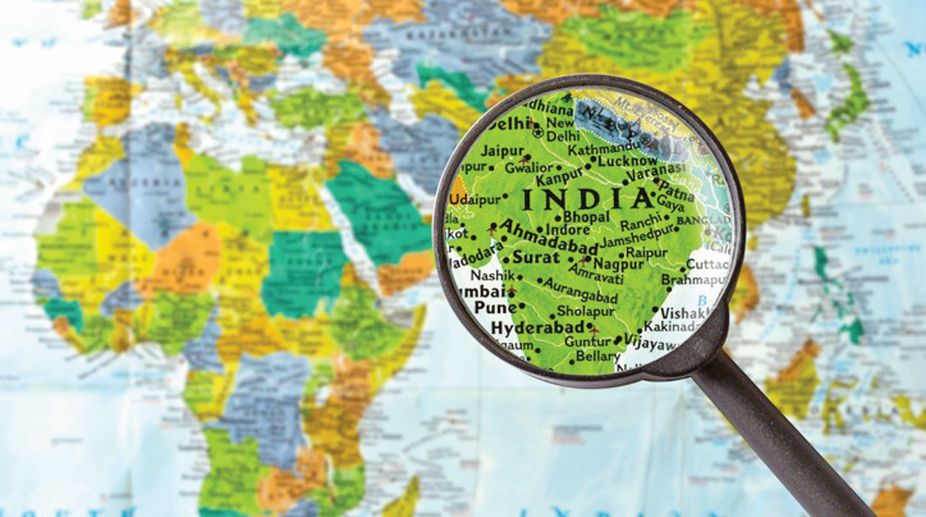The world is moving towards realpolitik, ignoring previous relations based on history, commonality of religion and humanitarian considerations. India is a growing powerhouse in both economic and military terms and thus is sought after. It is a market for every nation seeking to expand trade as also a security provider in the larger Asian region. With this changing profile, international leaders are keen to engage with India.
Across the globe, terrorism is a major threat, which India has kept under control. Further, China has begun pushing its weight on its smaller neighbors.
It has become aggressive over its territorial claims including in the South China Sea. Its loans at higher rates of interest are trapping developing countries. Its trade policies are resulting in balance of payments shifting in China’s favour. The US seems to be withdrawing under Trump, its traditional outlook of supporting its allies becoming more doubtful by the day. Into this gap India is wading in, a reliable friend, willing to support and invest as also provide a lucrative market. Thus, leaders are flocking in.
Advertisement
Benjamin Netanyahu, the Israeli Prime Minister visited India recently, the leaders of Asean were guests for the Republic Day and the Canadian Prime Minister arrives next month for a week’s visit. The US Ambassador to India stated that the US even seeks to exchange liaison officers with the Indian military, taking the relationship from the ‘strategic to the durable’. India is the new destination.
Economically India is one-fifth of China. Further, Indian aid is more project-related, though at very low interest rates, hence on occasions undelivered. Militarily it may not be as powerful as China, but as the army chief stated in his pre-army day press interaction, ‘India is not a weak nation’. It has shown the world that it would not back down if its core interests are threatened. Hence, alliances involving India are on the rise.
Asean leaders, who arrived in the country for the Republic Day parade, are seeking to enhance cooperation with India in both economic and security spheres. They like the US and Japan seek India as a counter balance to China. Thus, Indian security engagements with them would be on the rise. The Indian navy would be more engaged in visiting ports in the Asean region as also conducting bilateral and multi-lateral exercises.
There would be more exercises involving the army, with India sharing its expertise on handling terrorism. Many Asean nations are seeking to procure the BrahMos and Akash missile systems from India. These are clear Indicators of India’s growing military power.
Israel, though still enhancing ties with China is desirous to supply military hardware and partner India on matters of security and economic development. India-Israel ties have already shaken Pakistan, which feels that these are a threat to them. Similarly, the India-Asean meet is being closely monitored by China mainly because it considers this grouping as a threat to its relationship with these nations and may lead to a possible enlarged role for India in the South China Sea.
India is the seventh largest trading partner of Asean nations. It would seek to change that status. There are already thirty dialogue mechanisms between India and Asean, which includes an annual summit and seven ministerial meetings. India has changed its ‘Look East’ policy of the previous government to an ‘Act East’ policy, a clear shift in focus. India is seeking to actively enhance its relationships with these countries; thus all leaders willingly accepted India’s invitation to attend the event. Their combined presence indicates the standing of India in Asia.
Security concerns mainly due to the Chinese role would have dominated the agenda of the Asean-India meet. The India, US, Japan and Australia formed Quad has already raised eyebrows in China and would have also been noticed by Asean nations. Individually many of these nations already have security and joint exercise tie-ups with India, however not collectively.
The major issue for which a resolution or a common approach would always elude Asean is unanimity in its approach to China. Chinese investments in the region and the fact that China is a major trading partner would always be a hinderance. India on its part would be willing to support the nations in their seeking security, enabling economic development.
The US already considers India as a major defence partner and would desire joint patrols with India in the Indian Ocean Region, which India has avoided. With the signing of the LEMOA (Logistics Exchange Memorandum of Agreement), the range of the Indian navy has vastly increased. The Quad is clearly aimed at countering Chinese hegemony, while enhancing India’s role in the region. The Canadian Prime Minister would also be seeking to enhance military cooperation, apart from trade.
For India, while these interactions enhance its image and diplomatic power, it still has change its internal policies and cater for its military capability development. To become an effective global player, the Indian military needs to have a voice in the diplomatic circuit, an aspect which the government has avoided so far. Military diplomacy and soft power are issues which the government needs to incorporate as a part of its strategy for the future.
Simultaneously it must enlarge the role and scope of the Andaman and Nicobar Command, making it a formidable joint command with the ability to project power beyond the region. Its assets need to be increased as these would be needed to project Indian military power beyond its shores.
India is moving fast in its international outreach. It is sought after for economic and security reasons. Heads of state have made it a destination for economic and military cooperation. However, if India must remain a power on the global stage it should realise that economic and diplomatic power can only be effective if backed by resolute military power. Slowing military capability development would reduce the impact of its global outreach.
The writer is a retired Major-General of the Indian Army.











